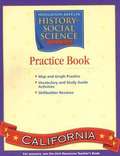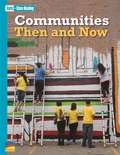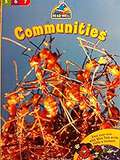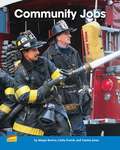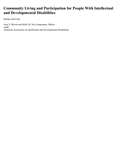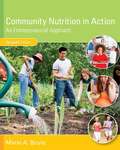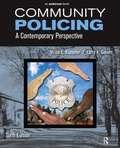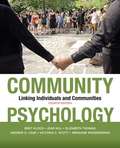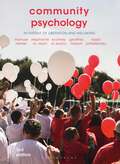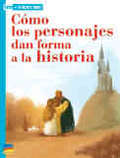- Table View
- List View
Communities Near and Far (Houghton Mifflin Harcourt Social Studies Leveled Reader)
by Herman J. Viola Sarah Witham Bednarz Carlos E. CortésCommunities Then and Now
by Julia Alvarez Benchmark Education CompanyNIMAC-sourced textbook <p>What were communities like long ago? Have communities changed? Read this book to learn about communities.</p>
Communities, Units 5-7
by Lucy Bledsoe Paula Rich Ann Watanabe Marilyn Sprick Karen Akiyama-PaikNIMAC-sourced textbook
A Community Cares and Shares (Into Reading, Level T #21)
by Diana NoonanNIMAC-sourced textbook. Who is in your community? A community is a group of people who live in the same area or have something in common. People in a community work together to make everyone feel safe and welcome!
Community Jobs: Set Of 6 (Early Connections)
by Margie Burton Cathy French Tammy JonesNIMAC-sourced textbook
Community Living and Participation for People With Intellectual and Developmental Disabilities
by Amy Hewitt Kelly M. Nye-LengermanCommunity Living and Participation for People With Intellectual and Developmental Disabilities is an exploration of how to create the ideal conditions to facilitate community living and participation for people with IDD. The book addresses the complex and ever-evolving dimensions related to both the place of community and the feeling of community, including living arrangements, work, other daytime activities, financial resources, relationships, personal interests, health and well-being, faith, opportunities for learning and personal growth, self-determination and informed decision making, and rights and responsibilities as a citizen. <p><p>The following topics are addressed specifically: using person-centered and positive support practices, housing, employment, social inclusion and relationships, self-determination and self-advocacy, supported decision making, health and wellness, planning for healthy and engaged aging, practices that promote quality outcomes, and the direct support workforce. Each chapter includes advance organizers, discussion questions, and a resource list. The book is ideal as an ancillary textbook at the undergraduate or graduate levels and as a staff development tool.
Community Nutrition In Action: An Entrepreneurial Approach
by Marie A. Boyle David HolbenCOMMUNITY NUTRITION IN ACTION introduces the program planning, policies, resources, and nutrition issues specific to community nutrition and provides an understanding of creating and implementing nutrition programs from various constituencies (elderly populations, children, impoverished populations, college students, etc.). Successful practitioners in community nutrition have proven to have a mind and skill set that opens them up to new ideas and ventures. Incorporating an entrepreneurial approach, this book helps readers learn how to take risks, try new technologies, and use fresh approaches to improving the public's nutrition and health status. The book also delivers the core material important to those who will be active in solving community nutritional and health problems, including program delivery, nutrition education, nutrition assessment, and planning nutrition interventions.
The Community of Washington, D.C.
by Bernice RappoportPerform this script about four trick-or-treaters who use math skills to share their Halloween candy.
Community Policing: A Contemporary Perspective (Sixth Edition)
by Victor E. Kappeler Larry K. GainesCommunity policing is a philosophy and organizational strategy that expands the traditional police mandate of fighting crime to include forming partnerships with citizenry that endorse mutual support and participation. The first textbook of its kind, Community Policing: A Contemporary Perspective delineates this progressive approach, combining the accrued wisdom and experience of its established authors with the latest research based insights to help students apply what is on the page to the world beyond. 'Spotlight on Community Policing Practice' sections feature real-life community policing programs in various cities, and problem-solving case studies cover special topics. The text has been revised throughout to include the most current developments in the field such as how the current climate of suspicion associated with terrorism threats affects the trust so necessary for community policing, and how the newest technologies can be harnessed to facilitate police interactions with citizens. Additionally, the book now explores the fragmentation of authority and emphasizes the importance of partnerships among the numerous law enforcement agencies, government agencies, and private social service agencies. Community policing expands the police mandate beyond fighting crime to include solving community problems in partnership with citizens. New edition is updated and revised, and has new coverage of: community policing, terrorism, and homeland security; community policing and technology; and community policing and the fragmentation of authority. Study aids in the book include key concepts, learning objectives, chapter summaries, and discussion questions. Online study aids include self-quizzing, topic-specific case studies that help students turn theory into practice. Instructor aids include customizable lesson plans that connect chapter-based learning objectives to specific resources, text bank, powerpoint lecture slides, video clips of authors summarizing each chapter, and links to additional video and online resources.
Community Psychology: Linking Individuals and Communities
by Bret Kloos Jean Hill Elizabeth Thomas Andrew D. Case Victoria C. Scott Abraham WandersmanThe fourth edition of this textbook provides an in-depth and engaging overview of community psychology, including its theoretical underpinnings and methods for conducting research and promoting change within communities. This book aims to get students, including nonpsychology majors, excited about the field and being agents of social change. New to this edition are an increased focus on values, particularly those related to social justice, empowering minority communities, and solving complex societal problems--like poverty, oppression, and climate change--across multiple ecological levels. <p><p> New research and case examples present important developments in the field and society at large, accompanied by extensive discussion questions that will encourage self-reflection and help students apply key concepts to their own lives. A new marginal glossary also highlights important concepts.
Community Psychology: In Pursuit of Liberation and Well-Being
by Manuel Riemer; Stephanie M. Reich; Scotney D. EvansThis visionary textbook is the third edition of a trusted and highly respected introduction to community psychology. The editors have focused on three contemporary social issues in order to illustrate key concepts throughout the book: climate change, affordable housing and homelessness, and immigration. Featuring a wide range of critical perspectives from international scholars and practitioners, Community Psychology encourages students to consider theories and methodologies in light of how they might be applied to different cultures and settings. <p><p>It develops students' ability to think critically about the role of psychology in society, and about how the work of community psychologists can aid in the liberation of oppressed groups, promoting social justice and flourishing both for people and for our planet. This book is essential reading for students taking both undergraduate and graduate courses in Community Psychology and its related fields.
¿Cómo crecen los ingredientes de tu ensalada? (¡Arriba la Lectura!, Big Book Unit 4 #8)
by Francie AlexanderNIMAC-sourced textbook
¿Cómo duermes tú? (¡Arriba la Lectura!, Level G #46)
by Ellen JavernickTodos necesitamos dormir, pero no todos dormimos del mismo modo. NIMAC-sourced textbook
¿Cómo es Brutus? (¡Arriba la Lectura! Level M #19)
by Debbie Croft Mark GuthrieNIMAC-sourced textbook
Cómo funcionan las ilusiones ópticas (¡Arriba la Lectura!, Level U #46)
by Bruce NaylorNIMAC-sourced textbook
Cómo hacer una balsa pequeña (¡Arriba la Lectura! Level E #87)
by Debbie Croft Lindsay EdwardsNIMAC-sourced textbook <p><p> ¡Hagamos una balsa pequeña! Es fácil y divertido. Este libro explica cómo hacerla.

